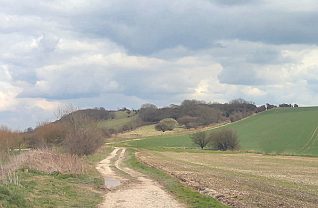Tenantry Downland

Please note that this text is an extract from a reference work written in 1990. As a result, some of the content may not reflect recent research, changes and events.
c) TENANTRY DOWNLAND: Until the nineteenth century the pasture rights to most of the downland in the parish of Brighton which was not arable belonged to the several landowners of the laines (see above), but it was leased to tenants as sheep pasture (commemorated by Tenantry Down Road and Tenantry ward). By the 1820s development of the town was rapid and the landowners, who included Thomas Read Kemp, Charles Scrase Dickins, John Wickels and Nathaniel Kemp, agreed in 1822 to divide the remaining downland that had not been cultivated in proportion to their holdings in the laines for easier disposal. {2}
Virtually all the remaining open downland in the borough is now the property of Brighton Council which has made many purchases since the 1890s, and especially in the 1920s and ’30s, in order to protect the beautiful downland itself, to safeguard the water supply, and to provide some building land. Large estates at Mile Oak , Devil’s Dyke, Saddlescombe, Waterhall, Patcham Court, High Park, Hollingbury , Stanmer , Moulsecoomb , Bevendean , East Brighton and Balsdean have been acquired, and the council now owns some 16,000 acres of land, most of which is let to tenant farmers. {305}
Any numerical cross-references in the text above refer to resources in the Sources and Bibliography section of the Encyclopaedia of Brighton by Tim Carder.




Comments about this page
You won’t find any sheep around Tenantry Down Road any more – just allotments and vegetable patches and the occasional racecourse – but for a flavour of what this laine must have been like in pastureland days, take the short walk (three miles each way) along the South Downs Way from Ditchling Beacon to Jack and Jill at Clayton. This passes through a fine unspoilt sheep pasture replete with said animals and a couple of splendid dewponds for good measure.
Add a comment about this page